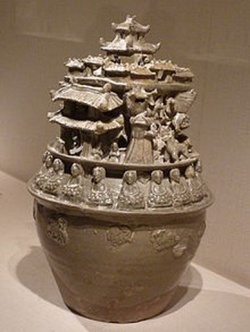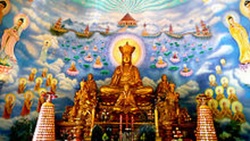Language in the Naturalistic tradition
For early Buddhists (e.g., the Theravādins ) intuition is the highest source of knowledge. This intuition (prajñā) is defined as "knowledge of things as they are in themselves as distinguished from what they appear to us."
• In general, the thrust of the Buddhist criticism of the Brahmanical viewpoint seems aimed more towards discrediting the unquestioning acceptance of a handed down tradition, rather than towards the rejection of śabda as having any possibility for truth bearing .
• The Jaina Prabhācandra defines a word as an independent aggregate of letters which are dependent on one another.
03. Language in the Naturalistic tradition
In opposition to the high evaluation given language in the Brahmanical {braah~ma.Na.} tradition, the naturalistic tradition tends to view language as an arbitrary and conventional tool. The validity of śabda and Veda {wé-da.} is denied as a source of knowledge. Professor T.R.V. Murti finds the Cārvāka and earlier Buddhism to be representatives of this tradition, while the "empiricistic" Jaina and Nyāya Schools occupy a somewhat intermediary position.
Like the Brahmanical viewpoint, the naturalistic tradition may be traced back to the Upaniṣads and early hymns of the [[Wikipedia:[[Wikipedia:Vedas|Vedas]]|[[Wikipedia:Vedas|Vedas]]]]. In his review of the naturalistic tradition of Indian thought, Riepe finds in the Rigveda "Some important assertion of a naturalistic approach to life." He admits, that there is no strong case to be made for the presence of presystematic naturalism in the Vedas , but he does find evidence that attitude of skepticism, hedonism and materialism were present in hymns such as the "hymn of Creation" (Ṛigveda X.129), and maintained in the Upaniṣadsby sages such as Uddālaka, the great opponent of the ṛṣi Yājñavalkya. Riepe feels that Uddālaka may be dated at 640-610 B.C. and is likely earlier than the Cārvāka or any of the first systemizations of a naturalistic school in India. He describes Uddālaka's position as follows: The point of view represented by Uddālaka appears to have been that of the Breath-Wind Magicians who held, as opposed to their idealistic opponents, that the breath rather than thought or words was the most important element of the human being; briefly, a distinction between holding stuff rather than thought to be primary. Of such Breath-Wind Magicians who foreshadow the later clear-cut naturalistic outlook, there are at least eighteen among the one hundred thinkers mentioned in the oldest Upaniṣads.
The step from the early naturalism represented by Uddālaka to the Cārvāka School is of considerable importance since "in the Cārvāka we have the first and possibly only unquestionable materialistic system in early India."
Cārvāka School
The Cārvāka School rejects śabda pramāṇa as completely false and accepts only the pramāṇa of perception as producing true knowledge. Sacred scriptures, religious injunctions, etc., are all considered useless. Everything is held to be derived from material elements (mahābhūta {ma.ha-Bu-ta.}) which are judged to posses their own immanent life force (svabhāva). Intelligence, thought and words are all seen as derived from these elements. There is no God, no supernatural, no immortal soul, and the only aim of life is to get the maximum of pleasure. (fn050-02)
Śabda pramāṇa is rejected by the Cārvāka on the grounds that it must first be established by other verbal testimony resulting in an infinite regress unless at some point there is an appeal to direct sensory experience. In addition to this logical reason for rejection Cārvāka also holds that śabda is unacceptable on epistemological grounds -- that it is impossible for perceptual knowledge to be communicated. The argument offered here is that a man knows only what he perceives, and not what someone else says he has perceived. (fn050-03) In this view the only referents are material, and direct sensory perception of such material referents is the only valid knowledge of reality.
Early Buddhism
Whereas for the Cārvāka sense perception was the only valid knowledge and pleasure produced by sensation the only goal, Buddha taught that "sense knowledge is considered to be inextricably bound up with feeling and desire, and hence is to be eliminated as far as possible because by its nature it is a stumbling block to the ultimate aim of the Buddha, the elimination of craving through understanding or illumination. (fn051-01) . For early Buddhists (e.g., the Theravādins ) intuition is the highest source of knowledge. This intuition (prajñā) is defined as "knowledge of things as they are in themselves as distinguished from what they appear to us." Such knowledge is considered to be the only means to freedom or salvation. This Buddhist concept seems virtually parallel to the Yoga concept of intuition which was discussed earlier. Prajñā is frequently conceived as an omniscient eye. Buddha, for example, was said to have gained such a divine eye on the memorable night of his over throw of the demon Māra. Through it he saw the entire knowable reality as if it were reflected in a clear mirror. Only such knowledge gained through one's own experience of intuition is considered to be valid. Sense experiences, words, inferences, etc., are worthwhile only as they help one to overcome the obstacles of ordinary experience, and achieve Prajñā for oneself. But, in themselves, śabda, sense perception, inference, etc., cannot be considered to give knowledge.
demon Māra
Skt-Devan: मार māra m. hindrance - SpkSkt
It is for this reason that Buddha rejected the Brahmanical {braah~ma.Na.} claims as to the authority of the Veda and its status as pramāṇa. The Vedic ṛṣis, he claimed, has no direct personal knowledge of the truth of the Veda. But, as was pointed out in the previous section of this chapter, such personal knowledge is precisely what was claimed by the ṛṣis. This contention of Buddha, therefore, was virtually a denial that the ṛṣis were competent persons whose testimony could be trusted. Aside from this, it seems clear that Buddha's intention was not to discredit all śabda as incapable of conveying truth, but to show that the truth or falsity of any statement is to be judged by factors other than its claim to be reliable report, self-evident, or authoritative revelation. As Jayatilleke puts it, Buddha's criticism "seems to presuppose that it is possible to determine the veracity of all the assertions by other means than that of revelation, etc., in so far as it is stated that what is accepted as reliable may prove in fact to be true or false." (fn052-01) In spite of the fact that his followers tended to make Buddha's words into the very kind of absolute authority he was rejecting, it seems clear that Buddha's view was that his own teachings and the path to freedom contained therein were only to be accepted provisionally by the disciple until found to be truth in his own direct experience (parjñā). Jayatilleke points out that this approach bears some similarity to the attitude of those sceptics who likewise suspend judgment when confronted with statements which may be true or false, but radically differs from it, "in view of the possibility, positively entertained, of knowing whether these propositions were in fact true or false in this life itself."
In general, the thrust of the Buddhist criticism of the Brahmanical viewpoint seems aimed more towards discrediting the unquestioning acceptance of a handed down tradition, rather than towards the rejection of śabda as having any possibility for truth bearing. Buddha is said to have compared the generations of Vedic teachers to a string of blind men clinging one behind the other in succession. Just because a succession of teachers or teaching is unbroken is no guarantee of its truth. (fn052-03) It is perhaps partly in response to this criticism of the early Buddhists that the Mimāṁsā School developed the apauruṣeya theory, which makes śabda impersonal, eternal, and therefore free from the corrupting influences of personality and ill-remembered transmission as alleged by the Buddhists. In addition to this there is the Vedānta claim that not only is śabda apauruṣeya but its truth is necessarily realizable by experience (anubhava) in this life if one is to achieve salvation.
anubhava 'experience' : rendered into Skt: अनुभव - need to check with a Skt Dict 101125
*Pal-Lat: anubhavati v. to enjoy, experience, partake of - UPMT-PED015
Pal-Myan: {a.nu.Ba.wa.} - -
This further interpretation by Vedānta would seem to satisfy the requirements for Buddha for confirmation in intuition and at the same time safeguard the Brahmanical claim that śabda (and Veda) is pramāṇa . Buddha's reply to this would likely be that while the study of the Vedas may lead to the intuition of truth, this is not necessarily so. One who does not hear the Veda but follows the path of moral living and inner concentration, as pioneered by Buddha, can have intuition of truth in the absence of śabda.
Jaina
knowledge or omniscience and is called kevala-jñāna. We have seen that this kind of absolute omniscience, while acceptable to the Sāṅkhya, Yoga and Vedānta, is rejected by the Mināṁsā on the basic that it exceeds the limits of personal perception and cognition (through the senses and mind as ordinarily known). This Mināṁsā objection is bypassed by the Jainas who agree that ordinary knowledge resulting from sense organs and the mind is incapable of omniscience, but that once these physical karmic obstacles are removed the self is capable of knowing all sensory and supra-sensory objects simultaneously so that even the limitations of time and place are superseded.
With this background we are now in a position to understand the Jaina view of śabda. Śabda is considered pramāṇa but is classed, along with inference, as only mediate or non-preceptual knowledge. The knowledge produced by the word of a reliable person and which is not inconsistent with the evidence of perception is called authority, verbal testimony, or śabda . A reliable person is defined as one "who knows the object as it is and describes it as he knows it. He who possesses right knowledge and makes a right judgment is said to be reliable or āpat." For these reasons he is taken as "authority" and his word is known as testimony. The testimony of śabda is held by the Jainas to be two kinds. It is called secular testimony (laukika) when the words come from an ordinary reliable person of the world (e.g., one's father). It is called scriptural testimony (śruta-jñāna) when it proceeds from a self liberated from the bondage of the karmic senses and mind and who is therefore omniscient. (e.g., Mahāvira).
The Jaina Prabhācandra defines a word as an independent aggregate of letters which are dependent on one another. . The way in which a word gives meaning is held to be a result of both its natural capacity for signifying, on the one hand, and the practice of convention, on the other. Regarding the debate as to whether the word denotes the universal or the particular, the Jaina view is that words denote both at the same time. Since objects as they exist are neither universal only nor particular only, so also words denoting objects are not one side only but invoke both aspects together. If, says the Jaina, a word denoted its object in its universal character and lacking any of its particular characteristics, then its object would be unreal since there is no universality without distinctive particular characteristics. Śabda, therefore, denotes both the universal and the particular characteristics of an object. In addition to this, Jainas view the positive word as having a negative or excluding function. The word "jar," for example, denotes the object jar but at the same time negates or excludes other objects, such as "cloth." For the Jaina, therefore, śabda denotes a many-sided object with its universal and particular characteristics, and its positive and negative characteristics.
Nyāya School
Like the Jaina, the Nyāya School holds that śabda is the teaching of a reliable person, and that it is a pramāṇa. As the only means of expressing knowledge is through a sentence, śabda as testimony occurs in the form of a group of words syntactically and significantly connected. As long as the meanings of the words composing the sentence are known, then the meaning of the sentence will be known as it is heard. Thus the cause of understanding relating to śabda is the knowledge of the meanings of words and not the referent object and its qualities. (fn056-02) The Nyāya opposes the Prabhākara Mimāṁsā contention that śabda must take the form of an injunction, and agrees with both Kumārila and Śaṅkara in maintaining that sentences conveying informative knowledge are also śabda.
Just as the Jaina is a realist, so also is the Nyāya in his theorizing that the objects of reality exist independent of any knowing mind. Knowledge, therefore, is simply the discovery by a conscious mind of the objects already existing. "Just as the light of a lamp reveals or shows physical things, so knowledge manifests all objects that come before it" . Śabda is one of the four sources of true knowledge. The others are pratyakṣa (perception), anumāna (inference) and upamāna (comparison). The adjective "true" in regard to knowledge is used advisedly, since according to the Nyāya, there can be false knowledge. Knowledge is said to be false when it does not correspond to the nature of its given object; and, true when it does correspond to the nature of its object. In answer to the question as a how correspondence to the true nature of the object is to be judged, Nyāya replies that the test of the truth or falsity of knowledge is the success or failure of our practical activities in relation to the object. The following example is offered. Wanting to add more sugar to your tea, you take some from the cup before you and stir it into your tea. The tea now tastes sweeter than before and you know that your previous perception of sugar was true. It may happen, however, that you come upon a cup filled with a white powdered substance and, taking it to be sugar, place a pinch of it into your mouth only to discover to your dismay that it is not sugar but salt. In this way it is shown that true knowledge leads to successful practical activities while false knowledge ends in failure and disappointment. The Nyāya School concludes therefore, "that the truth of knowledge is not self-evident in it, but is evidenced or known by inference from successful activity." By successful activity they mean that the expected result, arising from the knowledge claimed, is empirically experienced. This approach is common to the Jainas, Buddhists, and Vaiśeṣikas.
Following the above epistemology, the Nyāya takes śabda as neither impersonal nor self-evidently valid. It maintains that the |Vedas are created by God, and that, notwithstanding such divine authorship, their validity ultimately must be proven by perception or inference.
Nyāya classifies all knowledge from śabda under two headings: dṛṣṭārtha or that relating to sensuous objects, and adṛṣṭārtha or that relating to supersensuous objects. Chatterjee differentiates the two terms as follows:
Under the first head we are to include the trustworthy assertions of ordinary persons, the saints, and the scriptures insofar as they bear on the perceptible objects of the world. Thus the evidence given by witnesses in law courts, the knowledge about plants that we get from a reliable farmer, the scriptural injunctions about certain rites ... are illustrations of dṛṣṭārtha śabda. The second will include all the trustworthy assertions of ordinary persons, saints, prophets and the scriptures insofar as they bear on supersensible realities. Thus the scientist's assertions about atoms ... the prophet's instruction about virtue and vice, the scriptural texts on God, heaven, future life and the like are all illustrations of adṛṣṭārtha śabda. (fn058-01)
Although Chatterjeee admits that there is not complete agreement among the later Naiyāyikas to the above classification by Vātsyāyana, he maintains that in respect of truth all agree that there is no difference between the trustworthy assertions of an ordinary person, a saint, a prophet and the scriptures as revealed by God.
The Nyāyas define śabda as word as a particular group of sounds or letters arranged in a fixed order which stands for some thing or idea. The meaning of a word is seen to consist in its relation to the object which it signifies. Consequently, a word may have different meanings according to the different ways in which it may be related to an object. The Nyāyas find three different kinds of relation : abhidhā, paribhāṣā, and Lakṣaṇā. Abhidhā refers to the primary meaning of word. The relation between the primary meaning and the word may be either direct or indirect. If direct is leads immediately from the word to the knowledge of its meaning. Such a direct relation may be either eternal or non-eternal. When eternal it is called śakti .
Chatterjee observes that Indian logic leaves no room for the so-called "non-connotative terms" of Formal Logic as claimed by the West.
Dealing with the question as to how the unity of a word is cognized from the perception of its individual letters, the Nyāya answers as follows. Since we perceive only one thing at one instant, the individual letters cannot be perceived simultaneously and must therefore be perceived successively. But how can there be a synthesis of these successive perceptions into one word? According to the Nyāya it is by memory. As we perceive the successive letters c-o, traces of each letter are left in our mind. On the perception of the w, aided by the memory of the two preceding letters, the word cow as a whole is cognized and its meaning understood according to convention. Aside from the last clause (meaning being understood according to convention), this Nyāya view is in accord with the Vedānta and Mimāṁsā theories. However, it contains certain inherent difficulties. Since the Nyāya agree that there can never be more than one cognition, perception or image to be in the mind at one time, how can individual letters be synthesized into a unity when they are remembered if the memory is still individual? To answer this difficulty the Grammarian School proposes the Sphoṭa theory which we study in detail in Part II.
The Nyāya understanding of how śabda gives meaning in sentences seems to differ very little from the Mimāṁsā and Vedānta view discussed above. Chatterjee states, "The Nyāya, Mimāṁsā and Vedānta Schools all adhered to the abhihitānvaya doctrine." (fn061-01) Perhaps the main notable addition is that the meaning conveyed by a sentence must be determinative knowledge. Determinative knowledge is here defined as the knowledge of a thing as qualified by an attribute. Thus for the Nyāya the presence of a verb is not necessary for a sentence, [UKT *], rather it is the presence of "something to be related to something else as substantive to adjective." The meaning of a sentence therefore is the relation it expresses between a substantive and an adjective.
- See S. Chatterjee, Nyāya, p. 345, example of a sentence of this type : "A fiery hill" or "A red colour."
School. D. N. Shastri compares the two views as follows. "Whether the universal is considered to be positive and real according to the realist, or negative and unreal according to the Buddhist, its function is admitted to be two-fold by both of them, viz., (i) inclusion of the common objects of a class, and (ii) exclusion of the objects belonging to all other classes. The realist lays more emphasis on the positive aspect declaring the universal to be an objectively real entity. The Buddhist, however, insists on the negative aspect and describes the universal as a mere mental construction which is objectively unreal." D. N. Shastri, Critique of Indian Realism, p. 368.
Kevala Jñāna
Kevala Jñāna (Skt: केवलज्ञान )or Kevala Ṇāṇa (Prakrit : केवल णाण) in Jainism, (also known as "absolute knowledge", "Enlightenment" and "Omniscience") is the highest form of knowledge that a soul can attain. A person who has attained Kevala Jñāna is called a Kevalin. He is also known as Jina (the victor) or Arhat (the worthy one). A Tirthankara is a kevali who preaches the Jain doctrine and establishes the Jaina order. It is derived from two words – Kevala, which means “absolute or perfect” and Jñāna, which means "knowledge". Kevala is the state of isolation of the jīva from the ajīva attained through ascetic practices which burn off one's karmic residues, releasing one from bondage to the cycle of death and rebirth. Kevala Jñāna thus means infinite knowledge of self and non-self, attained by a soul after annihilation of the all ghātiyā karmas. The soul who has reached this stage achieves moksa or liberation at the end of his life span.
Jñāna – Knowledge
According to Jainism, pure and absolute knowledge is an intrinsic and indestructible quality of all souls. However, because of the accumulation of different types Jñānāvaraṇīya karmas, this quality of soul loses potency and becomes obscured. On the right are shown the types of knowledge:
While other types of knowledge are prone to error on account of delusion, only Kevala Jñāna is perfect and free from all errors.
Two aspects to Kevala Jñāna
There are two aspects to Kevala Jñāna : complete realisation of self and omniscience, complete knowledge of non-self.
A person who attains Kevala Jñāna realises the true nature of his soul. He remains engrossed in his true self. He is free from all desires and detached from all worldly activities, as he has achieved the highest objective that can be achieved by the soul.
Secondly, Kevala Jñāna also means complete knowledge of all the activities and objects in the universe. Jain texts describe the omniscience of Mahavira in this way:
When the Venerable Ascetic Mahavira had become a Jina and Arhat, he was a Kevali, omniscient and comprehending all objects; he knew and saw all conditions of the world, of gods, men, and demons: whence they come, whither they go, whether they are born as men or animals or become gods or hell-beings (upapada), the ideas, the thoughts of their minds, the food, doings, desires, the open and secret deeds of all the living beings in the whole world; he the Arhat, for whom there is no secret, knew and saw all conditions of all living beings in the world, what they thought, spoke, or did at any moment.
The Kevala Jñāna of Mahavira
Mahavira is said to have practised rigorous austerities for 12 years before he attained enlightenment:
"During the thirteenth year, in the second month of summer, in the fourth fortnight, the light (fortnight) of Vaisakha, on its tenth day, when the shadow had turned towards the east and the first wake was over, on the day called Suvrata, in the Muhurta called Vigaya, outside of the town Grimbhikagrama on the bank of the river Rjupalika, not far from an old temple, in the field of the householder Samaga, under a Sal tree, when the moon was in conjunction with the asterism Uttaraphalguni, (the Venerable One) in a squatting position with joined heels, exposing himself to the heat of the sun, after fasting two and a half days without drinking water, being engaged in deep meditation, reached the highest knowledge and intuition, called Kevala, which is infinite, supreme, unobstructed, unimpeded, complete, and full. (120)
Kevala Jñāna is one of the five major events in life of a Tirthankara and is known as Jñāna Kalyanaka and celebrated by all gods. Mahavira’s Kaivalya was celebrated by the demi-gods, who constructed the Samosarana or a grand preaching assembly for him.
Kevala Jñāna and Moksa
Kevala Jñāna and Moksa are intricately related. Moksa, or liberation, can only be attained by the enlightened beings who have attained Kevala Jñāna. After the death or nirvana of a Kevalin, he becomes a Siddha, a liberated soul in a state of infinite bliss, knowledge, perception and power. It is a permanent and irreversible state, free from sufferings, births and death. It is a state of permanent untrammeled bliss.
Supreme Non-attachment or Vītarāga
There is a direct relationship between Supreme Non-attachment and Omniscience. In the higher stages of meditation or dhyāna, one first attains the state of Vītarāga wherein one is completely freed of all feelings of attachment to all else other than one's soul. Once a permanent state of Vītarāga is achieved, omniscience follows. This is because omniscience is the basic nature of the soul and it is merely clogged by the presence of the 8 types of karmas in the soul. The attainment of Vītarāga ensures that the 4 types of destructive karmas known as ghatiya karmas are dissociated from the soul permanently. Hence, since the destructive karmas are not present in the soul any more, the soul attains omniscience, its natural attribute.
Source
[[Category:Buddhist Logic]]






